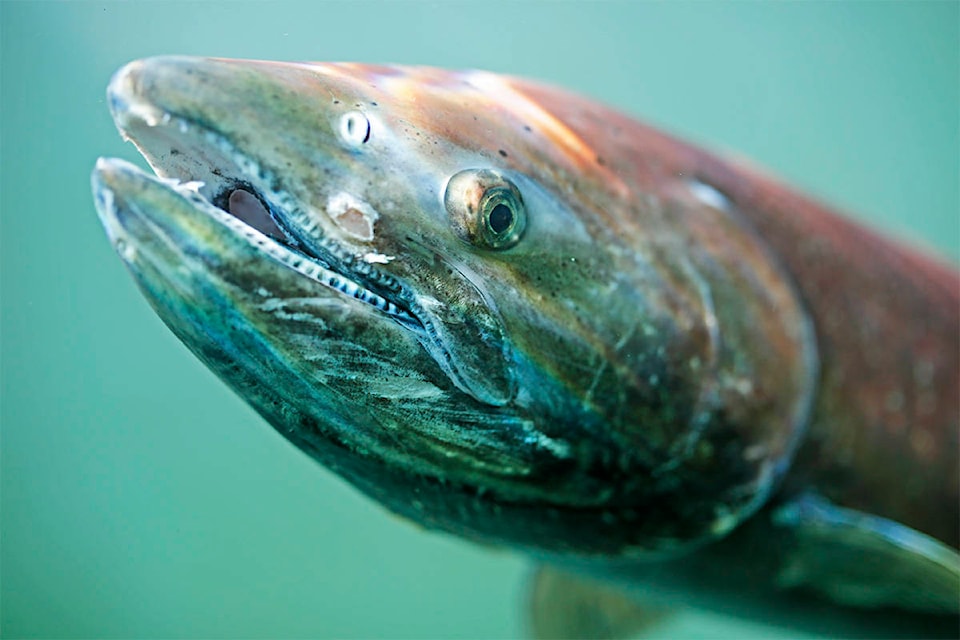Concerns are mounting on both sides of the Alaska-Yukon border that this year’s Yukon River Chinook salmon run will not see enough fish enter Canadian waters to meet either spawning or harvest goals.
Alaska officials painted a grim picture during an in-season international teleconference on July 28 — as of the day before, only 15,041 Chinook had been counted at the Eagle sonar, near the border, at the halfway point of the run.
The escapement goal this season, as it’s been for years now, is to get between 42,500 to 55,000 fish to their Canadian spawning grounds.
“Anyone can do the math on that — if you multiply (15,000) by two, we will not meet the lower end of the spawning escapement goal … not to mention the harvest share that we also need to provide to Canadian First Nation fishermen who also rely on these fish,” Holly Carroll, the summer season area management biologist for the Alaska Department of Fish and Game, said on the call.
“So this is a very scary time for us.”
Alaska has closed fishing in its management district directly adjacent to Canada — District 5 — in an effort to get as many Chinook as possible across the border, forbidding the use of even small nets meant to catch other species of fish in order to eliminate the chance of incidental catches.
Should the efforts prove unsuccessful, it would be the second year in a row that the escapement and harvest allowance goals won’t be met. In 2019, 45,560 Chinook made it into Canada along the Yukon River, but, taking First Nations harvest and other causes of mortality into account, it was impossible that at least 42,500 made it to their spawning grounds.
Under international treaty, Alaska is supposed to ensure that its management practices get enough Chinook across the border both to meet escapement goals and to provide enough fish — 23 per cent of the run, minus the fish set aside for escapement — for Yukon First Nations to harvest.
While this year’s Chinook run had started off slowly, officials had been hopeful after a total of 160,000 fish were counted at the Pilot Station sonar, near the mouth of the Yukon River.
“Based on what we saw at Pilot, we were expecting Eagle to do better than it’s doing, so we’re a little surprised, but you know… it’s a disappointing season,” U.S. Fish and Wildlife Service biologist Gerald Maschmann said on the call.
Steve Smith, a manager with Fisheries and Oceans Canada, said the department was anticipating taking a conservative approach to management but would be keeping a close eye on the numbers coming from Eagle. Although 15,000 fish at the midpoint of the run is “significantly less than the 10-year average,” he said that Canadian officials were “cognizant that the run has been anything but normal,” noting, among other things, the high water levels seen throughout the river this year that could be slowing the fish down.
“We’re obviously concerned about the numbers we’re seeing at Eagle but are eagerly looking for those numbers to climb in short order,” he said.
Department biologist Michal Folks told the conference that all three of the Yukon sonar stations that had counted Chinook so far this season are recording numbers “significantly lower” than usual for this time of year: as of July 26, the sonar on the Klondike River, operated by Tr’ondëk Hwëch’in, had counted 270, while on average, it would have seen 1,900 pass by. The Pelly River sonar, operated by Selkirk First Nation, has seen an average of 4,001 fish by July 27; this year, it’s counted just more than 1,500. At Big Salmon, past years had seen 994 fish by July 25; in 2020, it’s counted 153.
In an interview, Yukon Salmon Sub-Committee executive director Elizabeth MacDonald said that while there was still hope, the current numbers are “very concerning.”
The entire run has been late this year, she noted, with, as Smith had mentioned, the fish having to fight through high water the entire migration.
“They’ve been fighting the extra current — it’s kind of like instead of taking a nice leisurely stroll up the hill, now you’ve got water pouring down it, rain hitting you in the face, it just makes it much more difficult so you expend more energy,” she explained, noting that Chinook don’t eat during migration and only have so much energy to spare.
The poor showing at Eagle so far could mean that the fish are taking it slow to conserve energy — or, that they’ve had to fight so hard against the water that they don’t have any left to make it there.
“Fingers crossed that we get a late showing of Chinook, and they have been late this year so there is some hope,” she said. “I’m just not overly optimistic given the high water.”
Contact Jackie Hong at jackie.hong@yukon-news.com
